Introduction
Glossy abelia is a fine-textured, semi-evergreen, sprawling shrub with 1½ inch-long, red-tinged leaves arranged along thin, arching, multiple stems. It is a hybrid between A. chinensis and A. uniflora. It stands out from other plants because the leaves retain the reddish foliage all summer long, whereas many plants with reddish leaves lose this coloration later in the summer. Considered to be evergreen in its southern range, glossy abelia will lose 50% of its leaves in colder climates, and the remaining leaves will take on a more pronounced red color. Reaching a height of 6 to 10 feet with a spread of 6 feet, the gently rounded form of glossy abelia is clothed from spring through fall with terminal clusters of delicate pink and white, small, tubular flowers. Multiple stems arise from the ground in a vase shape, spreading apart as they ascend into the foliage.
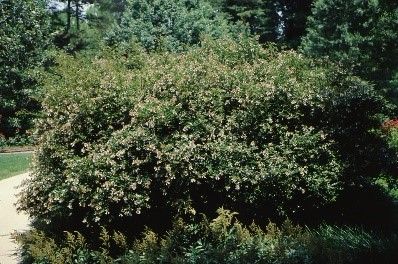
Credit: UF/IFAS
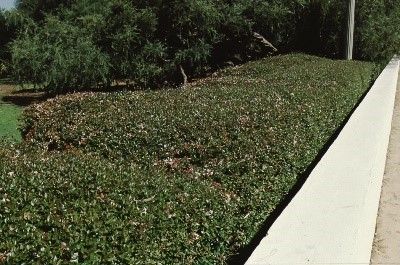
Credit: UF/IFAS
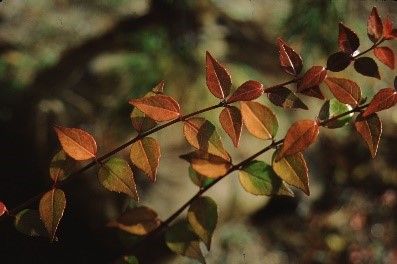
Credit: UF/IFAS
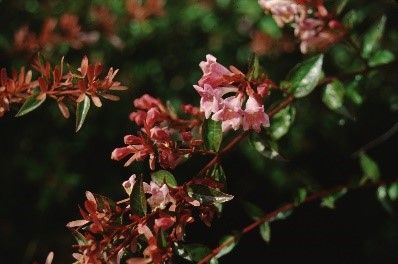
Credit: Edward F. Gilman, UF/IFAS
General Information
Scientific name: Abelia x grandiflora
Pronunciation: uh-BEEL-ee-uh gran-dif-FLOR-uh
Common name(s): glossy abelia, largeflower abelia
Family: Caprifoliaceae
Plant type: shrub
USDA hardiness zones: 5 through 9 (Figure 5)
Planting month for zone 7: year round
Planting month for zone 8: year round
Planting month for zone 9: year round
Origin: not native to North America
Invasive potential: not considered a problem species at this time and may be recommended by UF/IFAS faculty (reassess in 10 years)
Uses: border; mass planting; container or above-ground planter; superior hedge; specimen; screen; cascading down a wall. Attracts butterflies.
Availability: somewhat available, may have to go out of the region to find the plant
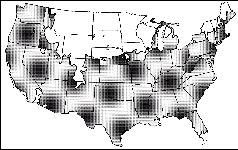
Description
Height: 6 to 8 feet
Spread: 6 to 8 feet
Plant habit: vase shape; round; upright
Plant density: moderate
Growth rate: moderate
Texture: fine
Foliage
Leaf arrangement: whorled
Leaf type: simple
Leaf margin: serrate
Leaf shape: ovate
Leaf venation: pinnate
Leaf type and persistence: evergreen
Leaf blade length: less than 2 inches
Leaf color: purple or red
Fall color: purple
Fall characteristic: showy
Flower
Flower color: lavender
Flower characteristic: spring flowering; summer flowering; fall flowering; pleasant fragrance
Fruit
Fruit shape: oval
Fruit length: less than 1/2 inch
Fruit cover: dry or hard
Fruit color: tan
Fruit characteristic: inconspicuous and not showy
Trunk and Branches
Trunk/bark/branches: not particularly showy; typically multi-trunked or clumping stems
Current year stem/twig color: reddish
Current year stem/twig thickness: thin
Culture
Light requirement: plant grows in part shade/part sun
Soil tolerances: slightly alkaline; clay; sand; acidic; loam
Drought tolerance: moderate
Soil salt tolerance: poor
Plant spacing: 36 to 60 inches
Other
Roots: usually not a problem
Winter interest: plant has winter interest due to unusual form, nice persistent fruits, showy winter trunk, or winter flowers
Outstanding plant: not particularly outstanding
Pest resistance: no serious pests are normally seen on the plant.
Use and Management
Glossy abelia grows in an upright, spreading vase shape if left unpruned with numerous thin stems arising from the ground. Stems eventually branch near their tips forming a shrub with a full top and a thin bottom. The cascading nature of glossy abelia makes it ideal for use as a specimen, foundation plant, or shrub border. It also can be planted along a steep bank for erosion control, or it can be clipped into a hedge. Be sure that the top of the hedge is clipped narrower than the bottom to allow adequate light to reach the bottom foliage. This will help keep the plant full all the way to the ground.
Foliage arises maroon fading to dark green, lending a reddish cast to the plant during active growth. The small powderpuff-pink flowers add color continuously during the warm months. Blooming on new growth in the summer, glossy abelia benefits from springtime pruning and will require occasional thinning to keep it in bounds as a hedge. Thinning will help light reach the interior foliage, stimulating branching and creating a fuller plant.
Glossy abelia enjoys fairly rich, moist but well-drained soil in a full sun or lightly shaded location and has good drought tolerance. Plants become thin and unattractive in the shade and do not flower. Plant on 4- to 6-foot centers to form a screen or foundation planting, slightly closer for a hedge. The foliage darkens during the winter, but plants generally remain full all during the cold months.
Cultivars include: 'Confetti'—cream-variegated foliage, cream colored area turns reddish in cool weather, evergreen to about 10 degrees; 'Francis Mason'—new green foliage changes to glossy yellow as it matures, color more noticeable in full sun, light pink flowers, 3 to 4 feet high; 'Prostrata'—prostrate growth habit, white flowers, sometimes used as a ground cover; and 'Sherwoodii'—dwarf, to 3 feet, somewhat smaller leaves and flowers. Abelia 'Edward Goucher', a hybrid between Abelia x grandiflora and Abelia schumannii, has abundant lavender-pink flowers and showy red calyces, reaches 5 to 8 feet, and is best used in USDA hardiness zone 6 and south. It is superior to most other abelia due to the highly fragrant pink flowers.
Propagation is by cuttings of long, leafless, hardwood stems taken in November to January.
Design Considerations
Glossy abelia works well as a background or massing plant to highlight the forms and colors of companion plants. The fine texture and small leaves of the abelia will show well with contrasting plant features, such as large leaves, coarse texture, thick stems, and dark green color. Contrasting size and shape, such as low-growing groundcover with a sprawling, mounding form, will emphasize the upright, vase shape of abelia. To create plant masses in large areas, select plants with similar characteristics that blend with abelia. Similar textures include thin blades and clumping, arching forms of grasses and other vase-shaped, small leaved shrubs.
Pests and Diseases
No pests or diseases are of major concern, but abelia plants are occasionally bothered by aphids.